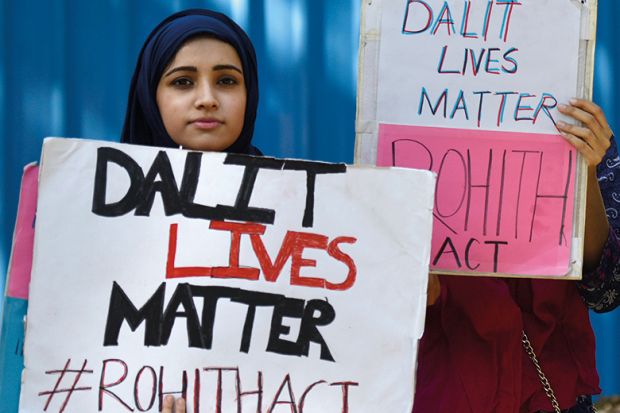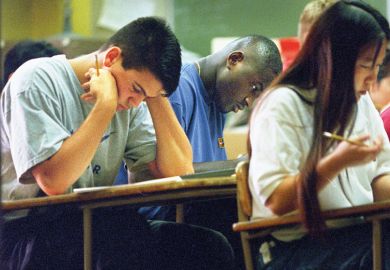Even as caste discrimination continues to plague Indian higher education, debate about the best way to tackle the issue in universities abroad – and even over its very existence – continues to polarise academia.
India’s caste system traditionally grouped people by four major castes based on their ancestry, with the lowest class, Dalits – formerly known as “untouchables” – traditionally barred from many types of work. In 1948, negative discrimination based on caste became illegal, but decades later, Dalits still struggle with access to education and jobs.
At Indian universities, it is not uncommon for them to encounter discrimination. The 2016 suicide of a Dalit student at the University of Hyderabad provoked public outcry, casting a spotlight on the issue.
Abroad too, there continue to be reports of prejudice targeted at lower caste Indian students. In January, the California State University system, covering 23 public institutions, specifically included caste in its non-discrimination policies.
While caste discrimination is more ubiquitous and explicit in India, it also exists overseas, said Suraj Yengde, a Dalit activist and a research associate in Harvard University’s department of African and African American studies.
“People might not call you names, but the things they might do are tantamount to caste discrimination,” he told Times Higher Education.
Dr Yengde recounted his experience of a higher caste Indian colleague who would “casually” make jokes and “infantilise” him, even though they would “pretend it was not intentional”. Still, the colleague would invite him to social events to “show me off as a token to other people”, he felt.
Sipra Mukherjee, associate professor of English at West Bengal State University, who teaches Dalit literature, said that the subtle nature of such incidents was part of what makes tackling the issue so tricky.
“Caste discrimination is extremely difficult to fight both within and outside India despite mechanisms here to address it. This is because much of the caste violence is quiet, routine violence which is difficult to pin down in concrete terms.”
She said that academics have a responsibility to promote the issue.
“We have to keep working on trying to make the evil visible – the more we talk about it and teach about it, the more it will be recognised, condemned and resisted.”
Saikat Majumdar, professor of English and creative writing at Ashoka University, said that both abroad and at home, institutions must call out and “shame” such behaviour.
“It’s bad enough that caste discrimination is practised in poor and remote villages in India, but it is absolutely appalling that wealthier, supposedly more ‘enlightened’ Indians who go abroad for higher studies also possess these prejudices,” he said.
Professor Majumdar welcomed steps taken by universities abroad to address such discrimination.
“Westerners have no idea of the immense degree to which bastions of knowledge, education, and white-collar labour have been historically monopolised by upper caste Hindus. It is worse than the old boys’ network in academic and professional circles,” he said.
While several scholars told THE that such discrimination is often subtle when encountered abroad, there is still disagreement over how widespread it is – and whether it is an issue at all.
“We don’t see ‘caste-based’ discrimination at UK universities,” said Kishore Dattu, a national committee member of the country’s Indian National Students Association (Insa).
Mr Dattu said that Insa believed policies targeting caste discrimination were the wrong approach.
“Since caste discrimination does not exist in UK universities, introducing caste-based legislation based on misinterpreted and misunderstood caste structures in the West will only inflame ruptures and dampen brotherhood among Indian students,” he said.
He worried that intervention by Western institutions, however well meaning, could muddle things further.
“There is a tendency for caste discussions to be very myopic in nature and generally by outsiders who don’t understand India or have hidden agendas, so when Indian students refute them, they aren’t taken seriously by the authorities.”
Dr Yengde, who strongly supports policies on caste, also cautioned against an ill-considered approach.
“The universities have got to do something, but the point is how and what are they going to do,” he said.
He believed that for meaningful headway, institutions should start with what they do best: research the problem. Dr Yengde also cautioned that institutional policy should be informed by the people it is meant to be serving.
“Without an active Dalit footprint on the policy I don’t think it will create as much of an effect as we’re anticipating.”
They could also set caste diversity as a criterion in their hiring practices, he said.
“I have not seen any institution in the world that has actively reached out to hire a Dalit academic and give them a mandate to work on this. That would be a better way to go about it than making resolutions or laws.”
后记
Print headline: ‘We must work to make the evil visible’




